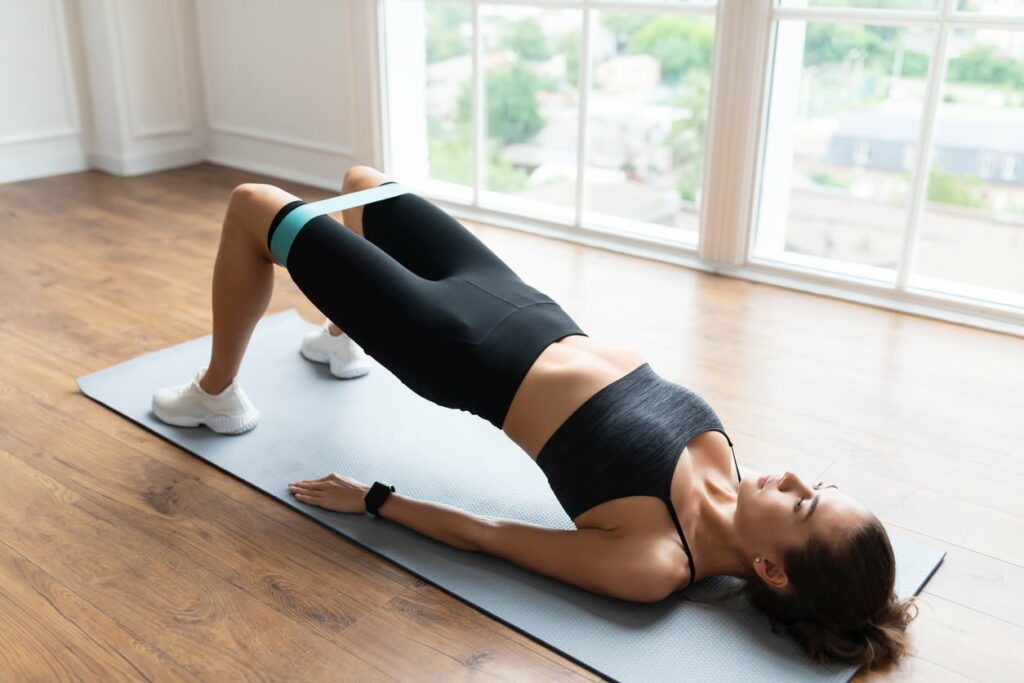
Summary
Welcome / Welcome / Tips for improving / Hip thrust: how to do it perfectly?
Hip thrust: how to do it perfectly?
You want to master the hip thrust to strengthen your glutes effectively? This exercise, pivotal for improve there strength and the shape of the glutes, requires precise technique to be executed successfully. Discover the basic principles, correct positioning and essential movements to get started and progress safely.
Summary
Know the hip thrust
The Hip Thrust is not just a strength training exercise; it plays a crucial role in improving your posture and preventing injuries. Learning how to do it correctly is therefore essential to reap the full benefits, while avoiding common mistakes that could compromise your progress.
What is Hip Thrust?
The Hip Thrust is an exercise muscle strengthening which mainly targets glutes. Originating in the world of bodybuilding and popularized by fitness trainers and athletes, this exercise has become a must-have for anyone looking to improve their strength and fitness.
This movement involves a extension of hip dynamic, usually performed in a lying position, with the shoulders supported on a bench or stable surface. Its effectiveness in activating the gluteal muscles makes it essential for any muscle strengthening routine, especially for those who aim to improve their sports performance or simply sculpt their figure.
Why the Hip Thrust is essential for your workout
The Hip Thrust is essential not only for develop muscle volume glutes, but also for improve posture overall. By strengthening the gluteus maximus, this exercise helps stabilize hips and reduce the risk of injuries in daily life and sporting activities.
In the context of power sports, such as sprinting or jumping, the Hip Thrust contributes significantly to explosive capacity. Athletes who incorporate this exercise into their training often see improvements in their performance, thanks to improved propulsive force.
For those who do not necessarily practice sports, the Hip Thrust helps to counterbalance the harmful effects of a sedentary lifestyle which can lead to weakness of the posterior chain muscles, increasing the risk of back pain and muscular imbalances. Thus, integrating Hip Thrust into your training routines ensures that you maintain a solid muscular base and optimal posture.
Muscles used during the hip thrust
THE gluteus maximus is the star of Hip Thrust. It's the most bulky and the most powerful of the gluteal muscles, and its main role is hip extension. When you perform a Hip Thrust, the gluteus maximus works intensely to lift the hips upward, allowing you to sculpt effectively this area of the body.
In addition, the hamstrings also play a crucial role. Located at the back of the thighs, they assist the gluteus maximus in the hip extension movement. By strengthening the hamstrings, you can not only improve your power but also reduce the risk of injury, as these muscles are often neglected in traditional workouts.
THE lower back, where the lumbar muscles, also acts as a stabilizer during the execution of the Hip Thrust. Although their role is less direct in the extension movement, they are essential for maintaining correct and safe posture throughout the exercise.
Muscle functioning during the Hip Thrust
The mechanics of Hip Thrust are based on dynamic extension of the hip, where several muscle groups interact in a synchronized manner. The gluteus maximus, as the prime mover, pushes the hips upward. Meanwhile, the hamstrings provide complementary strength to support this movement.
The interaction between these muscles is crucial for efficient and safe execution. The hamstrings, working in tandem with the gluteus maximus, allow powerful climb And controlled, while the lower back muscles ensure that the spine remains aligned and protected against possible stress or injury.
By understanding these dynamics, you can not only optimize the performance of your Hip Thrusts, but also avoid common mistakes that could compromise your muscle gains or your safety. Each repetition should be performed with particular care to properly engage these muscle groups, ensuring the best results while preserving your body.
Basic Hip Thrust Technique
Initial positioning for an effective Hip Thrust is crucial. Start by sitting on the floor with your back against a stable bench or platform at knee height. Feet should be placed flat on the floor, hip-width apart. Make sure the bench is sturdy enough to support your weight and movements.
Back placement is also key: the shoulder blades should rest on the bench, allowing you to create a stable pivot for your hip movement. This position helps maximize glute engagement while protecting your spine.
The optimal knee angle should be around 90 degrees when your hips are lifted. This allows for maximum activation of the glutes and hamstrings while minimizing pressure on the knees. Make sure your feet stay firmly planted on the ground throughout the exercise for added stability.
Execution of the movement
When climbing, focus on the contraction from your glutes to lift your hips toward the ceiling. Your body should form a straight line from shoulders to knees at the highest position. It is important to breathe correctly: inhale before starting the lift and exhale as you rise. This breathing technique will help you stabilize your core and maximize the force applied.
The movement should be smooth and controlled. Avoid swinging your hips or using momentum to go up. The rise should be strictly due to the strength of your glute and hamstring muscles, ensuring that you are working the right muscle groups effectively.
The descent is just as important as the climb. Control the movement by slowly lowering your hips toward the floor. Don't just let your body fall; maintain tension in your glutes and hamstrings throughout the descent. This helps increase time under muscle tension, which is crucial for building strength and mass.
Briefly reset your position on the floor before beginning the next repetition. Make sure your posture remains intact and you're ready to optimally re-engage your muscles for the next climb.
By following these steps and maintaining rigorous technique, you maximize the benefits of Hip Thrust while minimizing the risk of injury. Each repetition must be performed with precision to ensure that you get the most out of this powerful and transformative exercise.
Variations of the Hip Thrust
Hip Thrust with Equipment
The Hip Thrust with rod is a popular variation that allows you toincrease there resistance and D'intensify training. To perform this version, place a barbell loaded with weights appropriate for your strength level just above your hips. Use a cushion or specific protection for the bar to prevent any pain or injury to the pelvis.
When performing the movement, make sure the bar remains stable and the weight is evenly distributed on both sides. The lift should be performed by pushing the feet firmly into the ground, contracting the glutes to elevate the hips. The descent should be controlled, maintaining tension in the targeted muscles.
Tips for adjusting loads are essential: start with a light weight and gradually increase as your strength improves. This helps prevent injuries and ensures that technique remains correct despite the increased load.
Hip Thrust to the ground
The Hip Thrust on the floor, or Glute Bridge, is a great alternative for those who do not have access to a bench or who are new to this exercise. For this variation, lie on your back with your feet flat on the floor and your knees bent. Your arms should rest at your sides, and your palms can touch the floor for added stability.
The focus here is on thehip elevation towards the ceiling by contracting the glutes, without the help of a bench to support the shoulders. This version puts a little less pressure on the lower back, making it a favorable option for those who may experience discomfort with the standard bench version.
The advantages of this variant include its simplicity and accessibility, as no specialized equipment is required. However, it is important to note that precautions are still necessary, particularly regarding technique to avoid excessive strain on the neck or lower back.
By exploring these variations of the Hip Thrust, you can not only add diversity to your workout routine, but also tailor the exercise to your specific needs and training environment. Each of these options offers unique benefits and targets the glute and hip muscles in slightly different ways, contributing to complete and balanced muscle development.
Progress and starting weight
For beginners, it is crucial to start the Hip Thrust with a weight that allows you to maintain good technique throughout the exercise. Initially, you might even consider practicing the movement without weights in order to familiarize yourself with proper form. Once the basic technique is mastered, you can gradually introduce light weights.
Using a light barbell or even body weight at the beginning helps you focus on properly activating the gluteal muscles without risking overloading the back or other muscles that are not the primary focus of this exercise. exercise. The choice of starting weight should be such that you can perform around 10 to 15 repetitions without compromising form.
Progress
Once performing the Hip Thrust with an initial weight becomes comfortable and you can complete the sets without prematurely tiring, it is time to gradually increase the load. Increasing the weight gradually is essential to continue to stimulate the muscles and promote muscle growth and strength.
Progression can also include increasing the number of repetitions per set or adding more difficult variations, such as the unilateral Hip Thrust (one foot at a time) for an added challenge. It is recommended to increase the weight from 5% to 10% once you can complete two full sets at the current intensity without reducing the quality of form.
Recommended frequency and number of repetitions
To obtain good results, practice the Hip Thrust 2 to 3 times a week. This allows adequate rest time between sessions, essential for muscle recovery and injury prevention. As for the number of repetitions, a good starting point is to perform 3 to 4 sets of 10 to 15 repetitions.
The key is to listen to your body: if you experience pain other than the usual muscle fatigue, re-evaluate your technique and the weight used. Following these guidelines will help you maximize the effectiveness of the exercise while minimizing the risk of injury.
Common Mistakes and How to Avoid Them
The most common mistakes when practicing the Hip Thrust include lifting the load excessively, compromising form, and lack of control during the lowering phase. To avoid them, always make sure the movement is guided by glute strength and not momentum. Additionally, avoid elevating the hips beyond the body's natural alignment so as not to put strain on the lower back.
By considering these guidelines, you can lay a solid foundation for incorporating Hip Thrust into your workout routine, ensuring safe and effective progression.
Practical tips for optimizing Hip Thrust
To maximize the effectiveness of Hip Thrust and guarantee the best possible gains, here are some key tips to incorporate into your practice:
Isometric contraction: At the height of the rise, hold a glute squeeze for 1 to 2 seconds before lowering back down. This isometric break increases the intensity of the exercise and further strengthens the targeted muscles.
Engagement of the abdominal core: Activate your core throughout the exercise to stabilize your lower back and increase force transmission through the hips. It also helps protect your spine.
Proper breathing: Take a deep breath before lifting and exhale as you push your hips up. Good breathing helps stabilize the trunk but also maximize power during exercise.
Feet well positioned: Keep your feet flat on the floor, shoulder-width apart, and pointed slightly outward. This position promotes better activation of the glutes and greater stability.
Specific warm-up: Before you begin your Hip Thrust set, perform a focused warm-up that includes hip mobility moves and light exercises to activate the glutes, like glute bridges or quadruped hip extensions.
Integration into your training routine
To fully benefit from the benefits of Hip Thrust, it is important to integrate it wisely into your training routine:
Combination with other exercises: Integrate the Hip Thrust into a circuit that also targets other muscle groups for a balanced workout. For example, pair it with squats, deadlifts, and press exercises to work the lower body comprehensively.
Planning a typical session: Start your workout with exercises that require greater neuromuscular activation, such as squats or deadlifts, and finish with the Hip Thrust to specifically target the glutes when they are already pre-activated.
Training frequency and volume: To progress, Hip Thrust must be practiced regularly. Incorporate it 2 to 3 times per week, adjusting the volume and intensity based on your fatigue level and overall recovery.
Tracking progress: Note the weight used, the number of repetitions and sets, as well as your feelings during the exercise to gradually adjust your training and continue to progress.
By following these practical tips, you can not only improve the performance of your Hip Thrust but also maximize the benefits for your physical development and general well-being.
Conclusion
The Hip Thrust is a fundamental exercise to effectively strengthen the glutes and improve posture. Its correct technique, including positioning of the back and feet, maximizes muscle activation while minimizing the risk of injury. Thanks to the different variations presented, you can adapt the exercise to your level and your environment, using equipment or opting for simpler methods on the ground.
To progress, adjust the weight and frequency of training according to your abilities, avoiding common errors for safe practice. Tips like isometric contraction and proper breathing are key to increased efficiency.
Build muscle at DRIP
Push your limits and focus on improving your muscular strength with our training sessions. HIIT has DRIP ! Join us for sessions of 50 minutes full of intensity.
At DRIP, immerse yourself in a dynamic environment from the moment you enter, with seven workshops divided into three series to transform every moment into a captivating challenge. Our energetic coaches will guide you to the rhythm of memorable playlists. Accessible to all levels, DRIP offers the ideal environment to sculpt your legs effectively. You will love to hate us! ❤️🔥
Share
Tagged
Read also
follow us
on instagram
To follow all our news,
take advantage of our tutorials and participate
in our many competitions.
BREAKING NEWS!
Receive our newsletter.






